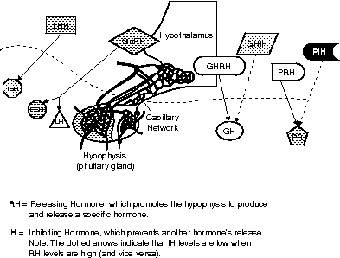Anatomy and Physiology: Hypothalamus: The Head Honcho
Hypothalamus: The Head Honcho
To get some perspective, you need to understand that the hypothalamus is really the main regulatory center in the body. That regulation involves both hormones and the autonomic nervous system (see The Central and Peripheral Nervous Systems). In fact, the hypothalamus acts as a link between the endocrine system and the nervous system. The location of the hypothalamus, as part of the most primitive portions of the brain, is related to the fact that evidence from the animal kingdom points to the ancient nature of many of our hormonal loops.
All endocrine organs have their hormones to enter a blood vessel (a vein from the endocrine gland) in order to ultimately reach their target organ (through an artery). The only problem with that is that the blood must travel all the way to the heart, then to the lungs, and then back to the heart, and get pumped out again before it gets to where it's going. In general, that's not much of a problem, despite seeming so inefficient, because the blood needs to go that way anyway. But what if the two organs are only a few millimeters apart, as in the hypothalamus and the hypophysis?
The answer to this dilemma is a nifty little portal system. In Cardiovascular and Lymphatic Circulation you learned that a portal system involves a connection between two capillary beds, thus bypassing the return to the heart, as in the hepatic-portal system connecting the capillaries of the abdominal organs and those of the liver. The hypophyseal portal system is much smaller, connecting the capillaries of the hypothalamus and the hypophysis. In this sense, hormones from the hypothalamus only have to travel a short distance to get to their target (see Figure 18.2).

Figure 18.2Note that the release of hormones from the hypothalamus affects the release of hormones from the hypophysis (pituitary). (LifeART©1989-2001, Lippincott Williams & Wilkins)
The following table indicates which hypothalamic hormones trigger the release of pituitary (hypophyseal) hormones, and which inhibit their release. This brings up the point that the hypothalamus, in general, releases regulatory hormones (that is, hormones that regulate the release of other hormones). Hormones that cause the release of others are called releasing hormones (RH), and those that inhibit are called inhibiting hormones (IH). The following table lists hormones of the hypothalamus and the pituitary hormones they regulate.
The Big Picture
To best understand the hypothalamus, you need to grasp how several concepts intersect. It's location, connecting it to both the endocrine and nervous systems, plays an important role here. The general area, surrounding the third ventricle, is related to the lack of the blood-brain barrier there (see The Nervous System), allowing full access to the contents of blood plasma. This, in turn, is necessary to the hypothalamus's role in maintaining homeostasis. By receiving info from the blood, the hypothalamus releases hormones that stimulate the pituitary, that in turn releases hormones that affect homeostasis. A nice little trick!
| Hormones of the Hypothalamus | ||
|---|---|---|
| Hypothalamic Hormone | Pituitary Hormone | Final Target |
| TRH: Thyrotropin RH | TSH: Thyroid SH | Thyroid gland |
| CRH: Corticotrophin RH | ACTH: Adrenocorticotropic hormone | Adrenal cortex |
| GnRH: Gonadotropic RH | FSH: Follicle SH testes cells | Follicle-ovary |
| LH: Luteinizing H testes cells | Follicle-ovary | |
| PRF: Prolactin releasing factor | PRL: Prolactin | Mammary glands |
| PIH: Prolactin IH | PRL: Prolactin | Mammary glands |
| GH-RH: Growth hormone RH | hGH: Human growth H | All body cells |
| GH-IH: Growth hormone IH | hGH: Human growth H | All body cells |
| MSH-IH: Melanocyte SH-IH | MSH: Melanocyte SH | Melanocytes |
There are, however, two exceptions. Antidiuretic hormone (ADH) and oxytocin (OT) are both produced in the hypothalamus, and then stored in the posterior pituitary gland (neurohypophysis), from which they are released. For this reason they are considered pituitary hormones, although that is a bit misleading. The hormones are produced by neurons in the hypothalamus, and then carried via slow axonal transport (they don't have far to go, after all) to the basement membranes of the capillaries in the neurohypophysis, making their distribution to the blood quite easy. The name of this part of the pituitary comes from the fact that these hormones are produced by neural tissue, rather than epithelial tissue, as in the anterior pituitary (adenohypophysis).

Excerpted from The Complete Idiot's Guide to Anatomy and Physiology © 2004 by Michael J. Vieira Lazaroff. All rights reserved including the right of reproduction in whole or in part in any form. Used by arrangement with Alpha Books, a member of Penguin Group (USA) Inc.
To order this book direct from the publisher, visit the Penguin USA website or call 1-800-253-6476. You can also purchase this book at Amazon.com and Barnes & Noble.







